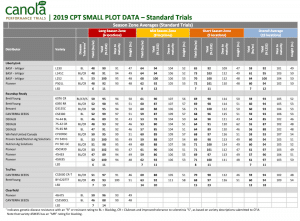A key step in clubroot prevention and management is to use clubroot-resistant (CR) canola varieties and use them in combination with other best management practices, including a minimum two-year break between canola crops (or any clubroot host) on each field. See all steps in the clubroot recipe.
Which CR variety should a grower use? It depends.
The long list of CR canola varieties available in Western Canada is posted and updated regularly in the “Control clubroot” section at clubroot.ca. Varieties with asterisks (**) beside the name have a CR trait different from or in addition to the Mendel (first generation) resistance. All varieties without asterisks contain the same Mendel (first generation) CR trait.
Varieties with novel or ‘second generation’ resistance traits should be used and rotated in fields where pathotypes are breaking first generation resistance. This is fairly common. For instance, it is already happening in Rocky View County where clubroot was first confirmed in 2018.
We know that a clubroot infestation will contain more than one pathotype and that no known CR traits are resistant to all of them. Therefore, growing any CR trait selects for pathotypes not controlled by that trait. The shift in pathotype populations can happen fairly quickly, especially under high spore loads. When growers see evidence of this shift (i.e. more clubroot even with a CR variety) it is time to grow a different trait.
Compare CR varieties. Twelve CR varieties were included in Canola Performance Trials for 2019. See the table below and click here to check out the complete 2019 booklet.


